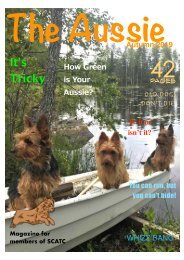The Aussie - Spring 2019
Magazine only for Members of the Southern Counties Australian Terrier Club
Magazine only for Members of the Southern Counties Australian Terrier Club
You also want an ePaper? Increase the reach of your titles
YUMPU automatically turns print PDFs into web optimized ePapers that Google loves.
Many of you will know that when you go to dog trainers and<br />
they are not just talking about obedience training, the trainers<br />
are always checking to see if you are holding your lead properly.<br />
Now you know why. As professionals we see the injuries and<br />
have had a few ourselves. Nothing quite as serious as the ones<br />
being highlighted by Surgeons, they probably only see the more<br />
serious ones, but s?ll painful. Experts reckon thousands of<br />
people could be at risk from lacera?ons, fric?on burns,<br />
fractures and ligament injuries.<br />
OK, so we know there can be a problem – what advice can we<br />
give you?<br />
<strong>The</strong> first thing to consider is the types of collars and leads that<br />
you are using. Or even harnesses if that is what you have<br />
decided to try. Many are more aUrac?ve than prac?cal. Nylon<br />
based materials notoriously can cut into your hand at the<br />
slightest tug. <strong>The</strong> thickness of the lead is another factor. In the<br />
show world, thin leads to not distract from the dog are part of<br />
the presenta?on. But with a coarse material and a dog needing<br />
checking, or its head being li\ed from sniffing the grass – well –<br />
handlers soon learn the discomfort from some leads. To win the<br />
top prizes, it can be a grin and bear it. But it’s for a short period<br />
of ?me.<br />
A dog walk - hopefully - is much longer than the 3 minutes of<br />
limelight in the show ring. Plus there is the unexpected that<br />
catches us off guard. <strong>The</strong>re is a trend to use retractable leads<br />
also known as extendable or flexi leads. <strong>The</strong>y are popular with<br />
dog owners as it enables us to give our dogs more freedom to<br />
roam, but also with seemingly a level of control. <strong>The</strong>se are<br />
usually long, thin cords (although there are "tape" or "belt"<br />
versions as well) housed into a plas?c compartment with a<br />
handle. <strong>The</strong> whole thing is spring-loaded and a buUon, which<br />
acts as a brake, controls how much of the leash is extended.<br />
<strong>The</strong>y typically range from around 10 feet to 26 feet in length.<br />
<strong>The</strong> convenience and flexibility of a retractable lead can actually<br />
work against you in some situa?ons. It takes prac?ce to be able<br />
to use it well, and let's face it, learning how and when to apply<br />
the brake, or how much freedom to give your dog, doesn't<br />
come easy to everyone. Many a dog owner has been seen<br />
struggling to get control of their dogs on an extendable leash.<br />
Obviously, it's harder to control a dog who is 20 feet away from<br />
you than it would be if they're on a standard 4 to 6 foot lead.<br />
Dogs can easily run out into traffic, have uninten?onal or invited<br />
contact with people or dogs, or get tangled up with another<br />
person or dog (which can be dangerous all on its own!).<br />
Many flexi-leads are essen?ally just a thin cord. Like any lead,<br />
they eventually wear out (or can be chewed through or<br />
weakened by chewing). Should the line or clip break, the<br />
tension on the leash can cause them to come whipping back<br />
towards you, poten?ally hiPng and injuring you.<br />
Likewise, if a dog ends up gePng tangled around other<br />
people or dogs, the cord can again cut the skin on legs or any<br />
other part that comes into contact with it. Plus gePng<br />
tangled up is a tripping hazard.<br />
Flexi-leads are equipped with a buUon that acts as a brake,<br />
preven?ng the lead from extending any further. If the buUon<br />
is pressed while the dog is running, or the dog simply<br />
reaches the end of the line, he'll come to an abrupt stop.<br />
This can result in neck and spinal injuries especially if the<br />
flexi-lead is used with a collar.<br />
Many dogs will enthusias?cally greet other dogs; gePng<br />
tangled up with another dog isn't uncommon. <strong>The</strong> cord<br />
might wrap around their legs, or even around heads and<br />
necks, depending on the difference in sizes of the dogs. Dogs<br />
can get cut by the lead or they may panic if they feel they're<br />
wrapped too ?ghtly and unable to move.<br />
To avoid injury from leads - dog owners should:<br />
<br />
<br />
<br />
<br />
<br />
avoid hooking fingers under a dog's collar<br />
not wind the lead around their hand<br />
not wrap leads around their wrist<br />
keep larger dogs on a shorter lead to avoid them<br />
building up speed<br />
Think twice when it comes to retractable leads<br />
Dog trainers are very aware of the damage that the wrong<br />
techniques of holding a lead can cause and will guide<br />
owners to the safest ways of holding the lead.<br />
<strong>The</strong>re is nothing like being demonstrated the technique and<br />
this would be the best advice. However, to give an idea of<br />
the right way – these images hopefully will assist and<br />
remind you of the safe way to hold a dog lead.<br />
Retractable leads are also notorious for causing cuts or<br />
lacera?ons. Because it's more difficult to control dogs when the<br />
lead is extended, it's only natural that people some?mes try to<br />
grab the line itself in an effort to regain control. <strong>The</strong> line cord<br />
can easily cut hands, fingers, and wrists, or cause "rope burns".<br />
Some of these injuries can be very serious - not just a mere cut<br />
that will heal quickly.









